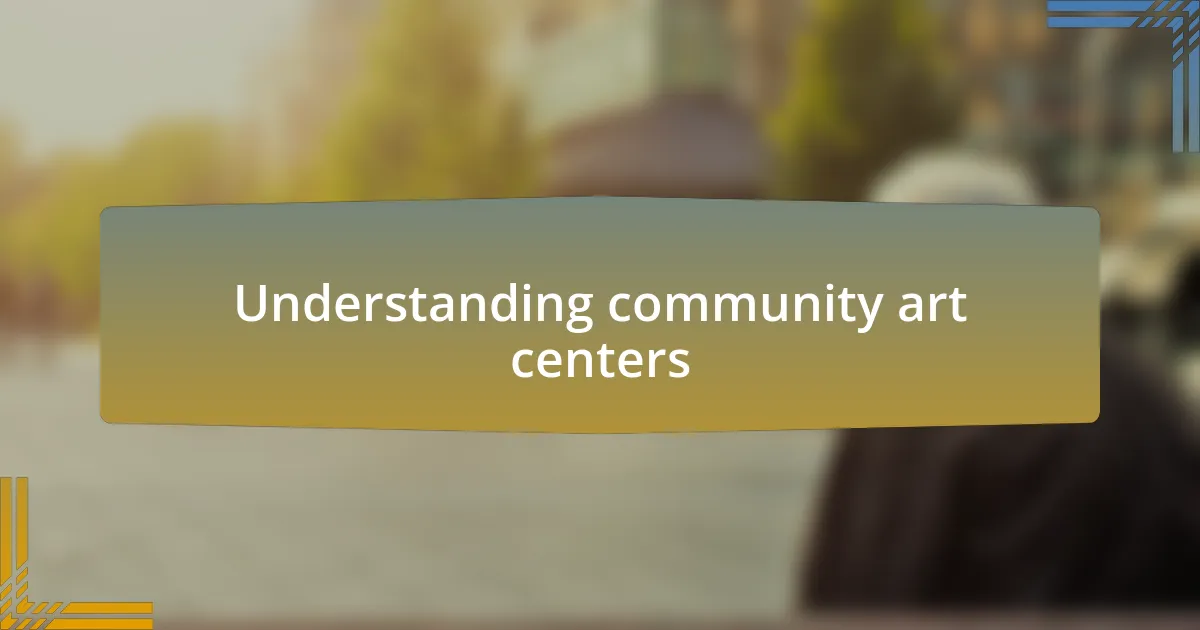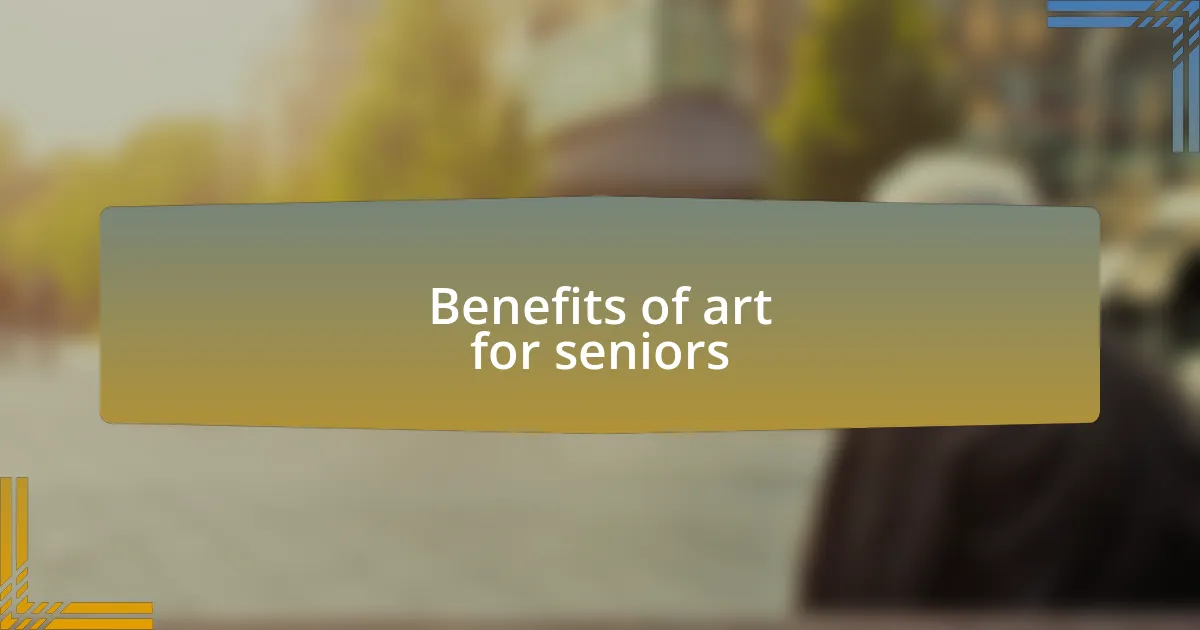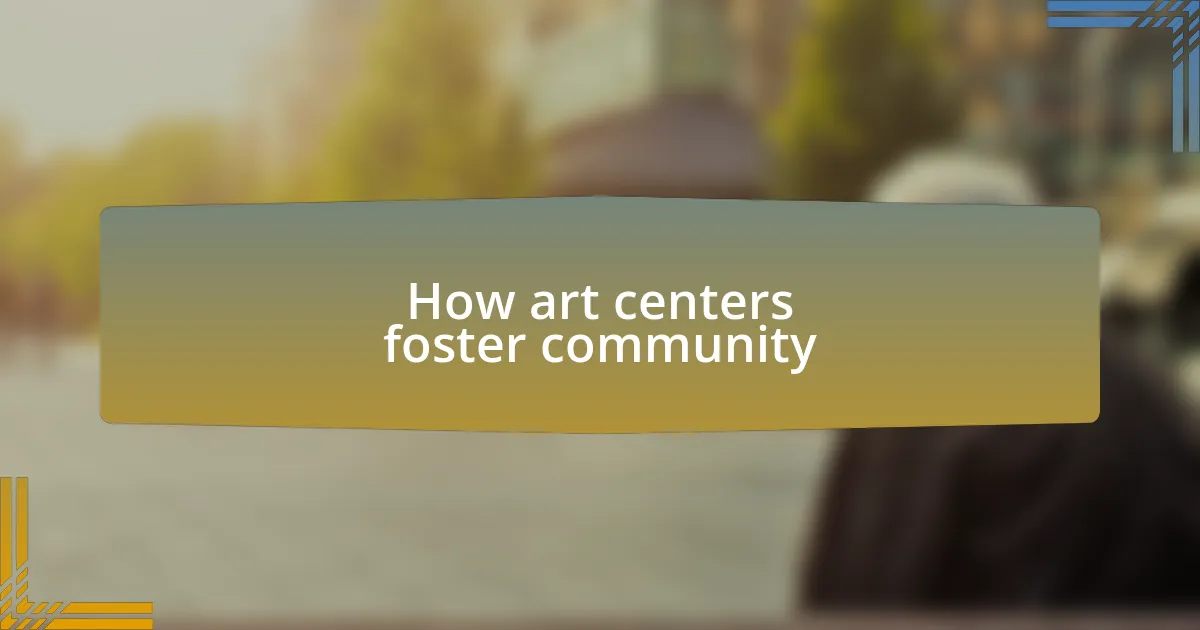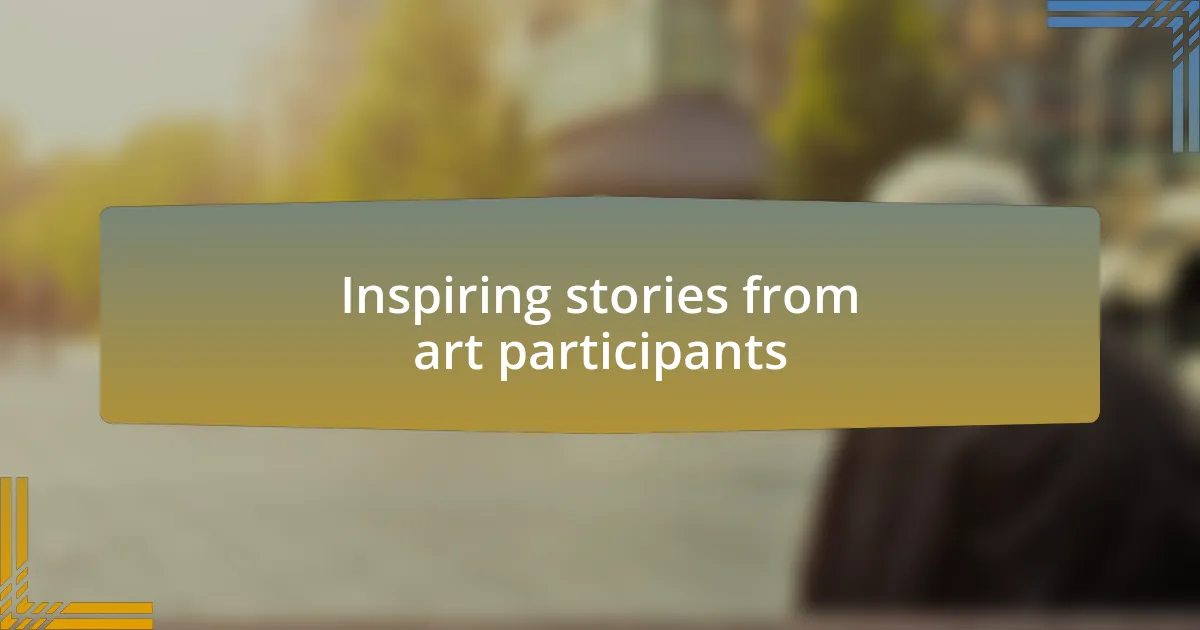Key takeaways:
- Community art centers promote creativity and connection, offering classes and fostering collaboration among local artists.
- Art in retirement enhances quality of life by providing therapeutic outlets and opportunities for social engagement, reducing feelings of isolation.
- Engaging in artistic pursuits helps seniors maintain cognitive function, revive memories, and build supportive friendships.
- Art centers encourage community dialogue on important topics, transforming art into a medium for connection and empathy.

Understanding community art centers
Community art centers serve as vibrant hubs that foster creativity and connection within neighborhoods. These centers often offer a variety of classes, workshops, and events, appealing to diverse skill levels and interests. I remember attending a pottery class at a community art center a few years back, and the feeling of sitting side by side with others, all shaping our clay creations, was truly exhilarating.
The emotional impact of these spaces cannot be overstated. They often provide a welcoming environment where individuals can express themselves artfully, which feels liberating. Have you ever experienced that rush of inspiration while standing in a room filled with art created by fellow community members? It’s a reminder of how much creativity can flourish in supportive spaces where collaboration thrives.
Moreover, community art centers frequently collaborate with local artists, enriching the cultural landscape of the area. From hosting exhibitions to offering mentorship programs, these centers play a crucial role in nurturing local talent. Personally, I find it heartwarming to see someone discover their passion for painting or sculpture, and I often wonder how many future artists are being shaped in these centers today.

Importance of art in retirement
Engaging in art during retirement can significantly enhance one’s quality of life. I’ve observed this impact firsthand at my local community art center, where seniors often share their stories through paint or clay. Watching them channel their experiences into beautiful creations not only fosters a sense of purpose but also cultivates a bond among participants that transcends age.
Art serves as a therapeutic outlet, especially in retirement when individuals may face feelings of isolation. I remember a friend, who took up watercolor painting after her husband passed away. Each stroke seemed to unveil her emotions, and it provided her with a sense of healing and connection to the world around her. Is there a better way to express deep feelings than through creativity? I believe there isn’t.
Furthermore, engaging in artistic activities helps maintain mental agility. Exploring new techniques or learning about art history stimulates the brain, keeping it active and healthy. For me, discovering a different art form challenges me in delightful ways, making each creative session not just an opportunity to create, but also a chance to grow intellectually and socially. Art, in essence, becomes a vital tool for enriching the retirement experience.

Benefits of art for seniors
Engaging in art helps seniors foster cognitive function, which can be incredibly beneficial as we age. I recall visiting a local art exhibition where a group of seniors showcased their sculptures. It was inspiring to see how their creative process not only kept their minds sharp but also encouraged discussions about techniques and inspirations. Isn’t it amazing how art can spark such lively exchanges that keep our brains buzzing?
Moreover, art has a wonderful way of reviving emotions and memories that may have faded over time. I once participated in a group collage project where everyone shared snippets of their past through photographs and drawings. The stories that emerged, tied to each piece, were powerful reminders of the lives they had lived. This deep connection to our history through creativity can be both healing and invigorating, reminding us of the richness of our experiences.
Additionally, artistic pursuits can foster social connections, reducing feelings of loneliness and isolation, which many seniors face. At a local pottery class, I observed how friendships blossomed among participants, each eager to share tips and support one another. Isn’t it heartwarming how a shared love for art can transform a simple class into a vibrant community? These interactions not only enrich lives but also cultivate a supportive network that many seniors greatly appreciate.

How art centers foster community
Art centers serve as vital hubs that bring people together, creating bonds that go beyond the canvas. I remember attending an open-mic night at my local art center. The diverse mix of performers, from poets to musicians, showcased not only their talent but also shared their stories. The laughter, applause, and communal spirit made it clear that these gatherings did more than entertain; they cultivated a sense of belonging that everyone craved.
Moreover, participating in community art projects allows for collaborative expression, breaking down barriers between individuals. I once joined a mural-painting event where participants of all ages contributed their ideas and artistic flair. Watching strangers transform into teammates as they painted side by side was a magical experience. It highlighted how art can unite people, instilling a shared purpose and camaraderie that fosters enduring friendships.
Lastly, art centers encourage dialogue about important topics within the community. I vividly recall a discussion panel hosted at an art gallery, where local artists addressed social issues, sparking thoughtful conversations among attendees. The atmosphere was alive with curiosity and respect, proving that art has the power to inspire change and bring people together for a common cause. How often do we find spaces like this, where ideas flow freely, and connections flourish?

Personal experiences with art centers
The first time I stepped into an art center, I was struck by the vibrant energy buzzing in the air. I remember attending a pottery class, hesitant but curious, feeling the cool clay between my fingers. It transformed from a simple lump into a bowl that mirrored my journey—crafted with imperfections, yet uniquely mine. That experience opened my eyes to the healing power of creativity in a supportive environment, where laughter flowed alongside our playful experimentation with the clay.
Reflecting on my involvement with a local art center, I fondly recall participating in a storytelling workshop. Each week, we gathered and shared personal stories, weaving our life experiences into a tapestry of voices. I was amazed at how much intimacy could develop through sharing vulnerable moments. It reaffirmed my belief that art isn’t just about aesthetics; it’s a powerful medium for connection and understanding.
One unforgettable evening stands out, when I attended an exhibit showcasing local artists with disabilities. The stories behind their pieces were deeply moving, filled with resilience and raw emotion. I often ask myself, how powerful is it to witness the world through another’s eyes—through art that speaks volumes? That night was a reminder that art centers are not just about creating; they’re about transforming our perceptions and awakening empathy within the community.

Inspiring stories from art participants
As I walked into the printmaking workshop at the community art center, I was captivated by the variety of voices around me. One participant, an elderly gentleman, shared his journey of rediscovering his passion for art after losing his wife. His intricate prints expressed sorrow and joy intertwined, sparking conversations that revealed how art can serve as a bridge over personal loss. Isn’t it incredible how creativity can help connect us through shared experiences?
During a collage-making session, a young woman bravely displayed her work, which depicted her struggle with mental health. She said each layer of her collage represented different emotions, creating a visual map of her healing process. Witnessing her vulnerability encouraged others to share their stories, showing me just how empowering it can be to express ourselves artistically. Doesn’t it remind you of art’s ability to foster community?
In a recent painting class, I encountered a retired nurse who found solace in creating landscapes filled with vibrant colors. She told us how painting helped her cope with the stresses of her former profession, allowing her to express emotions she hadn’t acknowledged. It struck me: how often do we overlook the therapeutic potential of art in our lives? Her story reinforced the belief that community art centers can be sanctuaries for healing and growth, inviting all of us to explore our creative journeys together.